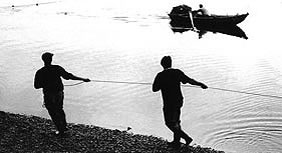The Salmon Net Fishing Association Of Scotland
The Salmon Net Fishing Association of Scotland was established in Aberdeen in 1906 by owners and lessees of salmon fishings on the east coast of Scotland, and is Scotland’s oldest fishermen’s organisation.
The Association’s objectives include defending, protecting and advancing the interests of salmon net fishing in Scotland, encouraging scientific research, and rendering assistance to those engaged in this work.
Ownership of Salmon Fishing Rights
All rights of salmon fishing in Scotland, whether in fresh water or in the sea, are held as private, heritable titles. Originally all owned by the Crown, over the years many have been conveyed to individuals by written Crown grants, and may be bought, sold or leased. Thus, today’s netsmen are either owners or tenants of the fisheries they operate, in the same way as the operators of rod fisheries. Where they differ is in the methods they use to catch salmon. In 2008 the netsmen’s share of all the salmon reported caught in Scotland was 13%.
-

A Jumper Net
-

A lone fisher returning with his catch
-

Net and Coble
Fixed EnginesFixed engine is an archaic term to describe the nets used since the early 1800s to catch salmon on the coast outside estuary limits. The two types still in general use are bag and stake nets; the latter include fly and jumper nets. All these nets rely on a behavioural characteristic of salmon, whereby they will lead along a netting barrier rather than attempt t o swim through it. Bag and stake nets consist of two parts, the leader which stretches seaward at right angles to the shore to the centre of the three chambered arrow shaped trap. Some of the salmon that swim along the leader may end up in the trap. Bag nets are usually fished along rocky shores where they are held in position by floated lines and anchors. They are fished as shown above from a flat bottomed boat (coble) crewed by 3-5 persons. Stake nets which include fly and jumper nets are fished on sandy beaches or mud flats where the stakes used to support the netting are set into the soft substrate. After erection they are fished by one man. |
Our picture shows a lone fisher returning with his catch after waiting for the tide to ebb sufficiently to allow him to enter the chamber at the seaward end of the jumper net and remove the single fish caught using a hand net, commonly called a ‘scum’. Haaf and poke nets are unique to the Solway Firth. Haaf nets are large hand-held nets which were brought to the Solway by the Vikings. Poke nets are net pockets held up on poles and arranged in lines set across the tide. There is strong community support to preserve these ancient traditional methods of fishing, not only for the sake of our cultural heritage, but also because the revenues raised by the sale of licences in the Annan Fishery District, for example, contribute to the Common Good Fund.
Net and Coble
Net and coble fishing dates back at least to the 12th Century and has changed little in the interval. It is the only method of net fishing presently permitted within estuarial limits. A curtain of netting gathered at the centre to form a pocket is paid out from the stern of the coble as it moves out from the bank and then downstream. A rope fastened to the end of the net paid out is towed downstream by a fisherman on the bank as the coble draws the net down the river. Once paid out, the coble turns towards the bank and both ends of the net are drawn ashore so that any fish encircled by the net are directed into the pocket and quickly landed to ensure the product is in pristine condition for the market. During the fishing season, outwith the weekly close time, netting is permissible 24 hours a day, but at most fisheries it is limited to a few hours either side of low water. At some stations shooting and hauling the net are repeated on a regular basis, while at others, shooting the net only occurs when fish are perceived to be present. A similar manner of fishing occurs in bays and sea lochs.